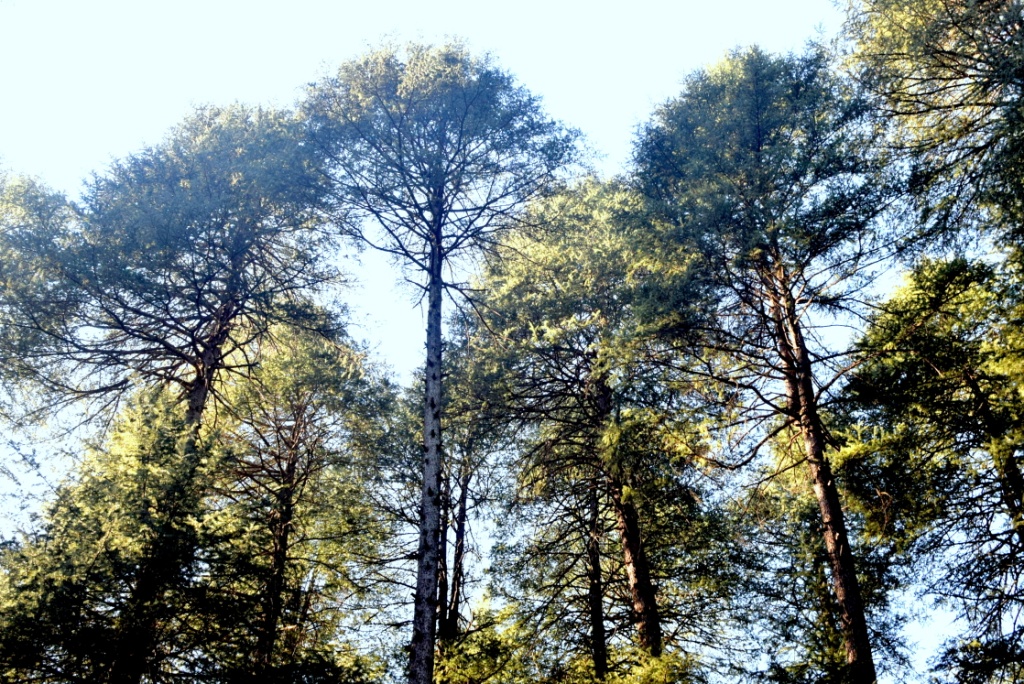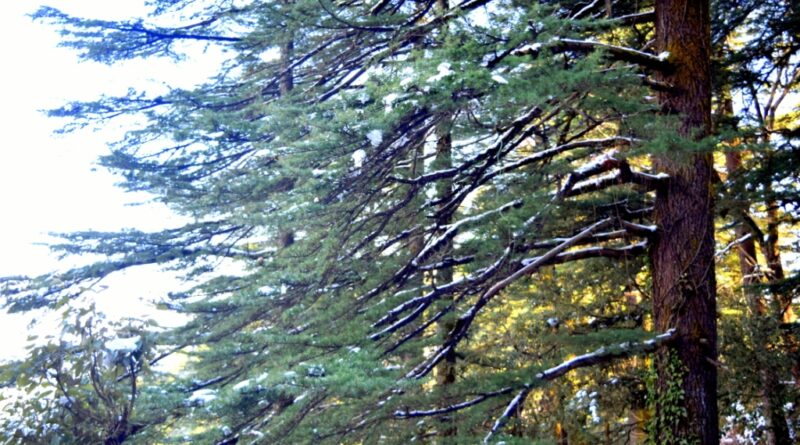The Deodara- Silviculture of Cedrus deodara-Know your trees
Cedrus deodara
(Family : Coniferae )
Synonym : Cedrus libani Var. deodara
Local Names : Deodar : diar; kilar; kelu
English/Trade Name : Himalayan Cedar; Deodar.
Distribution
Deodar is well distributed all over the Western Himalayas; from Kashmir in the west to Nepal in the east; between 1220 m and 3050 m altitude; most abundant between 1850 and 2600 m; altitudinal range being higher on the southern aspect than on the northern . It occurs extensively in the Himalayan moist temperate forests of Western Himalayas of Himachal Pradesh, Uttar Pradesh and Kashmir. Its main associates are Abies pindrow, Picea smithiana, Quercus semicarpifolia and Juglans regia on the higher altitudes, Pinus wallichiana and Q. dilatata on the lower, modified by the effect of aspect.

Particulars about Seed:
Male flowers appear June and female flowers in August; pollen is shed mid September to mid October; female cones (bearing seed) ripen in late October to November, 121/2 to 13 'A months after their appearance. These break up on the tree itself; scales and winged seeds fall on the ground and only the persistent axis remains on the tree. Some of the seeds in a cone are infertile. Good seed years occur once in three years, on an average. Cones are collected off the trees immediately before they open, end September to early October; placed in the sun for about a week till they open and break up. These are thrashed, cleaned and sieved to separate scales.
Seed is oily; it cannot be stored for long; it is best to sow fresh seeds before snowfall. At best, it may be stored in sealed tins till the following rains. Stratification method of storing and pre-treatment of the seed may be applied. 7000-9000 seeds weigh a kilogram; on an average 7900/kg. Germinative capacity is 65 - 80% and Plant percent 58.
Method of Propagation:
Natural Reproduction : Under favourable conditions of snowfall, good seed year, well distributed rainfall, soil conditions in respect of raw humus and weed growth, adequate sunlight under properly opened up crop, profuse natural regeneration comes up, which may be tended to establish. Prolonged dry spell after germination, in May-June, however prove disastrous as could be caused by fire and/or uncontrolled grazing.
Artificial Reproduction : It is necessary to supplement natural regeneration and/or to restock abandoned cultivation and burnt areas, to introduce or increase proportion of deodar in spruce and trail areas. Deodar is both sown and planted.
Direct Sowings : It is done broadcast, or along contour lines 3 m apart in well-worked 30 cm wide terraces, continuous or broken, or in patches of various sizes, 1.5 m x 0.5 m to 1.5 m x 1.5 m, spaced 2 m apart. These patches can serve the purpose of temporary nurseries for the next year as surplus seedlings are available for planting out; for this, patches are made 3.8 m apart, edge to edge in the lines. Sowing is done in November.
Planting
Nursery-raised seedlings, 21/2 to 3'/2 year old, are planted out in the field in auger-holes or in pits dug before hand, in late June-July, when rains have well set in. Seedlings are packed in bundles, with wet moss round the roots, on a cloudy/rainy day; roots should not be exposed to sun. Planting spacing will vary with various local factors; 2 m x 2 m to 2.5 in to 2.5 in. for pure planting; 3 m x 3 m to 3.8 m x 3.8 m for planting in mixture.
Nursery Practice
Nursery should be located in the optimum zone of deodar, on northern aspect; soil to be thoroughly worked and mixed with leaf mould. Reds should be raised; size usually 2 m x 1.2 in. Seed is sown in November-December just before snowfall, in drills 10-1.5 cm apart; 5 cm apart in drills, and covered with thorny twigs to protect against birds. Germination takes place in following spring, in March/April; as early as February and as late as May, depending on altitude and temperature conditions. Watering is necessary in May-June till reins start; seedlings are very sensitive post-germination drought. Nursery beds must be kept well weeded. Seedlings are pricked in July of the same year, 10 cm x 15 cm:, then again in July of second year, 15 cm x 23 cm; finally planted out in the field in Jul of third year, when about 30 - 45 cm tall. Less vigorous plants, and also those required to be planted in difficult locations infested with heavy weed growth, may be pricked out once again in the nursery and planted out in July of the fourth year.
Tending
Young crops, whether natural or artificial, have to be weeded adequately; with heavy weed growth, two weedings, one in July and other in August, are necessary in the first year; otherwise only one weeding in August will suffice. If weeds persist, continue weeding for 3 or 4 years.
Cleaning operations are required in the sapling stage to free them from overhead shade, while preserving side/lateral shade, by lopping or topping of branches, or girdling of inferior trees, if necessary. Cleanings are repeated at frequent intervals, and saplings suitably spaced also. Thinnings should begin early and be carried at intervals not exceeding 10 years.
Rate of Growth
Deodar is a slow-growing species. Rate of growth in plantations varies very widely, with locality.
Injuries, Pests and Diseases
Injuries :
(a) Climatic : Deodar is badly affected by drought in seedling stage; it is damaged by snow; snow-bending, breaking of branches or uprooting of poles. It is wind-firm and frost-resistant.
(b) Biotic : Birds eat away seed: bears remove bark of poles and saplings; porcupine and monkeys gnaw bark at the base; uncontrolled fire in the hot weather and unregulated grazing in intensity, time and place,cause immense damage; regulated grazing and control-burning before regeneration operations are beneficial.
(c) Climbers : Rosa moschata, Vitis spp.. Clematis spp.. Hedera helix cause varying degree of damage.
Insects : Larvae of brown moth. Euzophera cedrella destroy the seed, in half-grown cones in Jul. Cockchafer grubs destroy roots and cutworms (Agrotis spp.) bite through roots and stem.
Fungi : Fomes annosus attacks roots upward through cambium; Peridermium cedri attacks needles of current year's shoots causing "Witches Broom".
General
(i) Deodar is light-demander: can tolerate side shade in early stages.
It is sensitive to drought in seedling stage: it is frost-resistant; wind-firm; liable to snow damage. Uncontrolled fire and grazing are very injurious.
(ii) Deodar is one of the most important timber trees of India; others being Sal and teak; all naturally durable. Its timber is moderately hard and heavy, scented, very durable and easy to work. It is highly valued for building and bridge construction, joiner, furniture; very suitable for Railway Sleepers, but because of its limited supplies and very high prices on the one hand, and alternative materials being available for sleepers on the other, deodar is no longer used for this purpose.
(iii) Deodar oil is used for ulcers and skin eruption.
(iv) Deodar forests are worked under Selection System, or more often, under Uniform System or its modification, with concentrated regeneration, on a rotation of 120 or 150 years, and regeneration period of 30 years.



